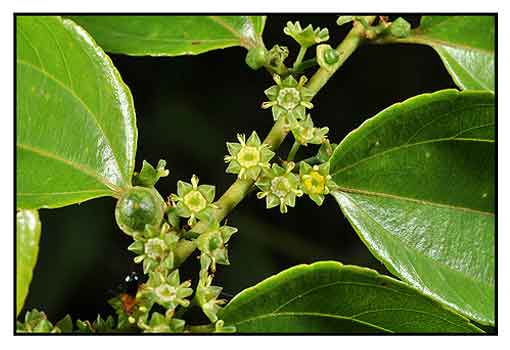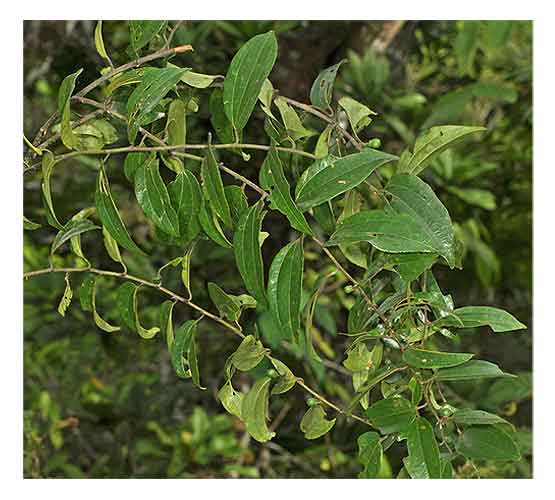 Gen info Gen info
- Ziziphus is a genus of about 40 species of spiny shrubs and small trees in the buckthorn family, Rhamnaceae, distributed in the warm-temperate, subtropical, and tropical regions of the world.
Botany
Ziziphus horsfieldii is a woody climber to at least 30 m long; girth at least 10 cm in diameter, spiny. Branches are terete, with longitudinal striations and conspicuous, raised lenticels, hairs sparse, c. 0.5 mm long mixed with shorter hairs ˂ 0.1 mm long, mostly appressed-antrorse, reddish to whitish. Stipules modified into spines, single, recurved, c. 2.5 mm long,subglabrous. Leaves weakly discolorous, drying greenish-brown, blade asymmetric, (lanceolate –) narrow ovate (– ovate), 3.5 – 10.0 × 1.2 – 4.5 cm, chartaceous to subcoriaceous, apex attenuate to acuminate, base cuneate to subcordate, usually clearly oblique, margins finely denticulate, c. 100  serrations on either side, each serration topped by a protruding callosity that dries darker than the lamina, c. 0.1 mm long; primary veins 3, impressed adaxially, raised abaxially, hairs sparse along primary veins on either side of lamina, often more densely adaxially, hairs c. 0.2 mm long; strong marginal veins coming off the outside of the two outer main veins c. 6 on either side, rarely < 5,ascending and gradually diminishing, not forming conspicuous loops near margin¸ no clear intramarginal vein running along the leaf margin present, angle of divergence with outer main veins c. 45°; transverse veins between the main veins weak but discernible, especially adaxially, coming off midrib at c. 90°, barely raised (not readily felt by touch), spaced by c. 1 mm from each other, more often slightly zigzagging than straight; higher order reticulations barely discernible; lamina subglabrous; domatia present in the axils at the base of the 3 main veins and at the junction between the marginal veins and the outer main veins, pocket-like and often with tufts of hairs, swelling often visible adaxially just above junction between 3 main veins; petiole slightly dorsiventrally flattened, c. 7 mm long, hairs dense, indumentum extending to widened base of main veins adaxially. Inflorescence of axillary pedunculate cymes, < ½ as long as subtending leaves, c. 12 flowers in each cyme, cymes loose dichasia with usually peduncle and first 2 branches clearly elongate and next 4 branches short but distinct; peduncles dorsiventrally flattened (5 –) 10 (– 15) mm long, hairs abundant, mostly < 0.1 mm long; pedicels c. 2 mm long, straight to slightly curved; bracteoles entire, narrowly triangular, c. 1 mm long, hairy. Flower faintly scented; hypanthium densely hairy on the outer surface, hairs ˂ 0.1 mm long, appressed-antrorse, greyish; sepals triangular, c. 1.2 mm long, pale greenish when fresh, glabrous and keeled adaxially; petals clawed, c. 1 mm long, obcordate, white; stamen filaments flat, subulate, c. 0.7 mm long, anthers c. 0.3 mm long, enclosed by petals; nectary disk yellow, pentagonal, 10-pitted, glabrous, annulus surrounding ovary barely raised; style arms 2, free for c. 1 mm, glabrous; ovary partially immersed, hairs dense. Fruit a drupe, ripening yellowish-green, (0.9 –) 1.1 (– 1.5) × (0.7 –) 1.1 (– 1.5) cm, obovoid [wider towards apex], indumentum dense, hairs drying reddish, < 0.1 mm long; fruiting pedicels c. 5 ×1 mm; hypanthium remains annular at base of fruit. (4) serrations on either side, each serration topped by a protruding callosity that dries darker than the lamina, c. 0.1 mm long; primary veins 3, impressed adaxially, raised abaxially, hairs sparse along primary veins on either side of lamina, often more densely adaxially, hairs c. 0.2 mm long; strong marginal veins coming off the outside of the two outer main veins c. 6 on either side, rarely < 5,ascending and gradually diminishing, not forming conspicuous loops near margin¸ no clear intramarginal vein running along the leaf margin present, angle of divergence with outer main veins c. 45°; transverse veins between the main veins weak but discernible, especially adaxially, coming off midrib at c. 90°, barely raised (not readily felt by touch), spaced by c. 1 mm from each other, more often slightly zigzagging than straight; higher order reticulations barely discernible; lamina subglabrous; domatia present in the axils at the base of the 3 main veins and at the junction between the marginal veins and the outer main veins, pocket-like and often with tufts of hairs, swelling often visible adaxially just above junction between 3 main veins; petiole slightly dorsiventrally flattened, c. 7 mm long, hairs dense, indumentum extending to widened base of main veins adaxially. Inflorescence of axillary pedunculate cymes, < ½ as long as subtending leaves, c. 12 flowers in each cyme, cymes loose dichasia with usually peduncle and first 2 branches clearly elongate and next 4 branches short but distinct; peduncles dorsiventrally flattened (5 –) 10 (– 15) mm long, hairs abundant, mostly < 0.1 mm long; pedicels c. 2 mm long, straight to slightly curved; bracteoles entire, narrowly triangular, c. 1 mm long, hairy. Flower faintly scented; hypanthium densely hairy on the outer surface, hairs ˂ 0.1 mm long, appressed-antrorse, greyish; sepals triangular, c. 1.2 mm long, pale greenish when fresh, glabrous and keeled adaxially; petals clawed, c. 1 mm long, obcordate, white; stamen filaments flat, subulate, c. 0.7 mm long, anthers c. 0.3 mm long, enclosed by petals; nectary disk yellow, pentagonal, 10-pitted, glabrous, annulus surrounding ovary barely raised; style arms 2, free for c. 1 mm, glabrous; ovary partially immersed, hairs dense. Fruit a drupe, ripening yellowish-green, (0.9 –) 1.1 (– 1.5) × (0.7 –) 1.1 (– 1.5) cm, obovoid [wider towards apex], indumentum dense, hairs drying reddish, < 0.1 mm long; fruiting pedicels c. 5 ×1 mm; hypanthium remains annular at base of fruit. (4)
 Distribution Distribution
- Native to the Philippines (Palawan, Mindoro).
- Also native to Andaman Is., Borneo, Jawa, Malaya, Nicobar Is., Sumatera.
(1)
- A liana that grows primarily in the wet tropical biome.
(1)
Constituents
- Phytochemical screening yielded tannin, saponin, flavonoid, triterpenoid, with absence of alkaloid and hydroquinone.
- Studies have yielded hexadecanoic acid, palmitic acid, 9-19-cyclolanost-23-ene-3,25-diol, (3.beta.,23E), 9-12-octadecadienoic acid (Z,Z), linoleic acid, octadecanoic acid, stearic acid, ergosta-5,7,22-trien-3-ol, (3.beta.,22E), ergosterol.
(2)
Uses
Folkloric
- No reported folkloric medicinal use in the Philippines.
-
In Indonesia, used to treat fever in children.
Studies
• Constituents / Cytotoxicity: On brine shrimp lethality testing, LC50 was 345.037 ppm. (see constituents above) (2)
Availability
Wild-crafted.
|

![]()






